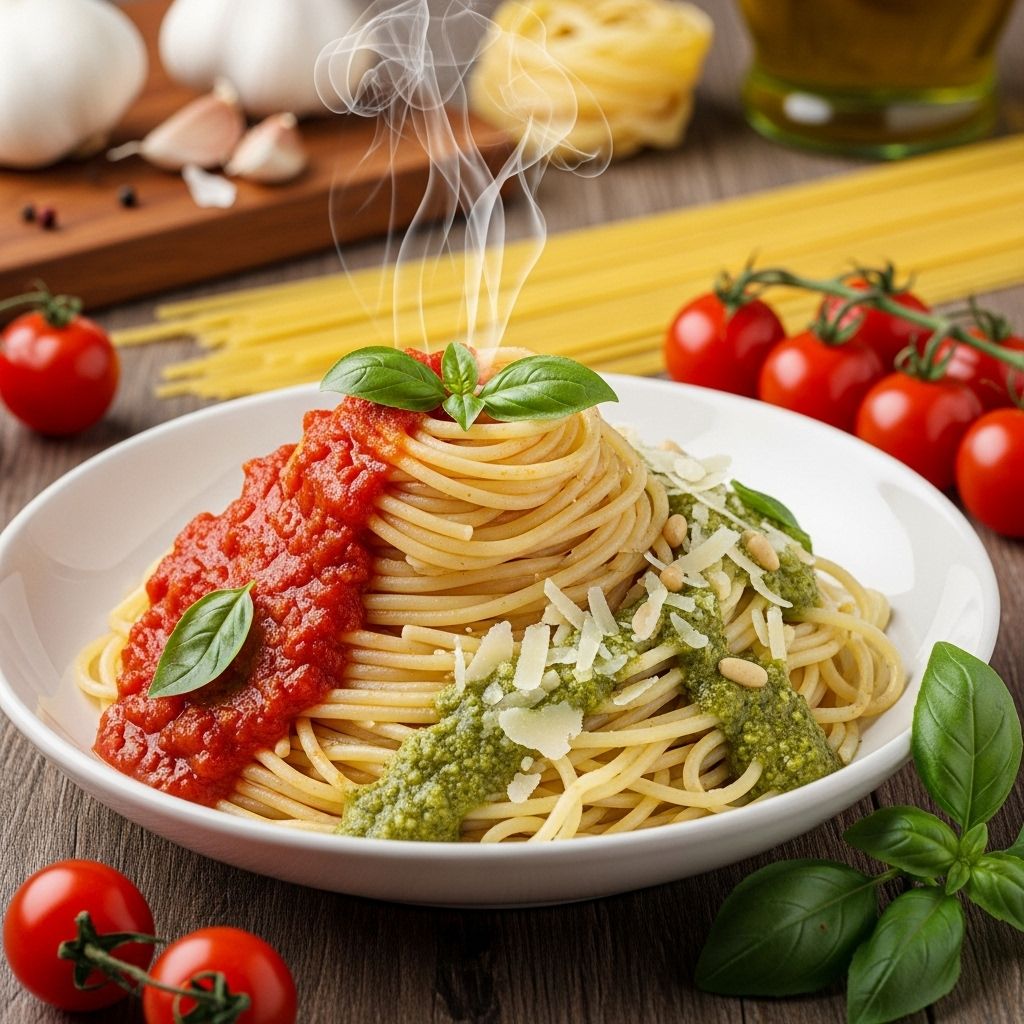Spaghetti: Nutrition, Health Benefits, Types, And Delicious Recipes
Discover the nutritional value, health benefits, varieties, and best ways to enjoy everyone’s favorite classic pasta: spaghetti.

Spaghetti is one of the world’s most beloved comfort foods—a versatile pasta cherished for its simple shape and endless adaptability. Whether paired with classic tomato sauce, vibrant vegetables, or rich proteins, spaghetti is more than just a staple in the kitchen; it is also a source of important nutrients and health benefits. This guide takes you through spaghetti’s nutritional profile, its potential positive roles in your diet, an overview of popular types, tips on choosing and cooking, as well as some tasty recipes and frequently asked questions.
What Is Spaghetti?
Spaghetti is a long, thin, cylindrical pasta that originates from Italy. Traditionally made from durum wheat semolina and water, its texture is naturally firm and slightly chewy when cooked “al dente.” The neutrality of its flavor makes it the ideal canvas for a wide range of sauces and preparations.
- Shape and Size: Typical spaghetti strands are 25-30 cm (10-12 inches) long and about 2 mm (0.08 inches) wide after cooking.
- Origins: Although commonly associated with Italian cuisine, variations of long, thin noodles are found worldwide.
- Versatility: Spaghetti pairs wonderfully with tomato, cream, or oil-based sauces, and is featured in both traditional and modern culinary creations.
Spaghetti Nutrition Facts
Spaghetti offers a balanced source of energy, plant-based protein, essential vitamins, and minerals. Here is a breakdown of the nutrition found in 100 grams (about 3.5 ounces) of cooked, unenriched spaghetti:
| Nutrient | Amount Per 100g (Cooked) |
|---|---|
| Calories | ~158 kcal |
| Total Carbohydrates | 31 g |
| Protein | 5.8 g |
| Fat | 0.9 g |
| Fiber | 1.8 g |
| Sugar | ~0.6 g |
| Iron | 0.63 mg |
| Magnesium | 18 mg |
| Potassium | 44 mg |
| Phosphorus | 44 mg |
| Thiamine (B1) | 0.07 mg |
| Niacin (B3) | 0.6 mg |
Note: Values may vary slightly based on brand and preparation method.
- Whole Wheat Spaghetti contains more dietary fiber, vitamins, and minerals compared to traditional refined varieties.
- Enriched Spaghetti may be fortified with extra iron and B vitamins (like folic acid), boosting its nutritional value.
Health Benefits Of Spaghetti
- Energy-Boosting: Rich in complex carbohydrates, spaghetti provides a steady source of energy, making it ideal for athletes, students, and busy individuals.
- High in Dietary Fiber: Especially in whole wheat forms, spaghetti supports digestive health, helps regulate blood sugar, and aids in overall gut function.
- Heart Health: Whole grain spaghetti contains soluble fiber and beneficial phytonutrients which can help lower cholesterol and maintain cardiovascular health.
- Supports Weight Management: Its fiber content promotes satiety, reducing overeating risks when consumed as part of a balanced meal with vegetables and lean protein.
- Micronutrient Source: Provides key minerals such as iron (important for oxygen transport), magnesium (crucial for muscle and nerve health), and B-vitamins (energy metabolism and neurological support).
- Plant-Based Meal Base: Great for vegetarians and vegans; can be combined with legumes, nuts, vegetables, and non-meat sauces for a nutritious main dish.
Is Spaghetti Healthy?
In moderation and as part of a well-rounded diet, spaghetti can contribute positively to overall health. The key lies in:
- Choosing whole wheat or enriched varieties for an extra nutritional boost.
- Pairing it with lean proteins, plenty of vegetables, healthy fats (like olive oil), and limiting heavy, high-saturated-fat sauces.
- Managing portion sizes to maintain a healthy caloric intake.
Those managing blood sugar or with celiac disease should opt for whole grain or gluten-free pastas, respectively.
Types Of Spaghetti
Spaghetti comes in a variety of styles and specialty options, allowing you to tailor your meal to your dietary preferences and recipe needs.
- Traditional Spaghetti: The classic refined wheat version, widely available and what most recipes call for.
- Whole Wheat Spaghetti: Made from whole grain flour, higher in fiber, protein, and micronutrients.
- Gluten-Free Spaghetti: Made from brown rice, quinoa, corn, or legumes (like chickpeas or lentils), ideal for those with gluten intolerance or celiac disease.
- Vegetable-Enriched Spaghetti: Contains added vegetable purees (such as spinach or tomato) for a subtle flavor and nutrient twist.
- Protein-Enriched Spaghetti: Includes added plant or dairy proteins; great for individuals seeking extra protein content.
How To Cook Spaghetti Perfectly
Getting perfect spaghetti is key to a delicious meal. Follow these steps for best results:
- Boil plenty of water in a large pot (about 4-6 quarts per pound of pasta).
- Add a generous amount of salt (1 tablespoon per 4 quarts) for flavor.
- Add spaghetti to boiling water; stir immediately to prevent sticking.
- Cook uncovered for 8-10 minutes (or as per package instructions) until al dente (firm to the bite).
- Reserve some pasta water before draining for loosening sauces.
- Drain spaghetti well and toss with your chosen sauce.
Tip: Do not rinse cooked spaghetti—this removes the starch needed to bind sauces.
Spaghetti And Its Role In A Balanced Diet
Spaghetti is often unfairly vilified due to its carbohydrate content, but it is actually a useful carbohydrate source when eaten as intended:
- As the base for nutrient-rich meals featuring protein (like beans, chicken, tofu, or seafood) and a colorful variety of vegetables.
- Helps reduce reliance on fatty or processed meats by serving as the bulk of comfort dishes (like spaghetti primavera, puttanesca, or aglio e olio).
- Can be included in the Mediterranean diet, which is linked to better heart and metabolic health.
Healthy Spaghetti Recipes
Try these delicious, wholesome spaghetti recipes at home:
1. Classic Tomato Spaghetti
- Ingredients: Spaghetti, olive oil, garlic, chopped tomatoes, onion, fresh basil, salt, crushed red pepper, grated Parmesan.
- Cook spaghetti as above. In a separate pan, heat olive oil, sauté garlic and onion, add chopped tomatoes and basil, simmer, then toss with spaghetti and top with Parmesan.
2. Spaghetti Aglio e Olio
- Ingredients: Spaghetti, extra virgin olive oil, garlic, red chili flakes, chopped parsley.
- Gently fry sliced garlic and red pepper in olive oil, toss in al dente spaghetti, stir in parsley, and serve warm.
3. Whole Wheat Spaghetti Primavera
- Ingredients: Whole wheat spaghetti, zucchini, broccoli, bell pepper, cherry tomatoes, olive oil, lemon zest, grated Parmesan.
- Sauté vegetables in olive oil, toss with cooked spaghetti, season with lemon zest and pepper, and finish with Parmesan.
4. Spaghetti With Lentil Bolognese (Vegan)
- Ingredients: Spaghetti (gluten-free or whole wheat as preferred), cooked lentils, crushed tomatoes, garlic, onion, carrot, celery, dried oregano, basil.
- Sauté vegetables until softened, add lentils and tomatoes, simmer until thick, season, and serve over spaghetti.
5. Spaghetti With Spinach And Feta
- Ingredients: Spaghetti, fresh spinach, feta cheese, garlic, lemon juice, pine nuts, olive oil.
- Wilt spinach with garlic in olive oil, toss with cooked spaghetti, add lemon juice and feta, sprinkle with toasted pine nuts, and serve.
Tips To Make Spaghetti Healthier
- Choose whole grain varieties for more fiber and a longer feeling of fullness.
- Add more vegetables for vitamins, minerals, and antioxidants.
- Use lean proteins such as chicken, turkey, beans, or seafood.
- Limit creamy or cheese-heavy sauces—opt for tomato- or olive oil–based instead.
- Control portion sizes: Aim for 1 to 1.5 cups of cooked spaghetti per person.
Possible Downsides And Considerations
- High Glycemic Index (GI): Regular spaghetti (from refined flour) can spike blood sugar. For sustained energy and better glycemic control, use whole grain or legume-based pasta.
- Gluten Content: Traditional spaghetti contains gluten and is unsuitable for those with celiac disease or gluten sensitivity. Always check labels for gluten-free options.
- Caloric Density: Mind sauces high in fat and cheese, which may make your dish calorie-rich.
How To Store And Use Leftover Spaghetti
- Store cooked spaghetti in an airtight container in the refrigerator for up to 4 days.
- Reheat gently on the stove or microwave with a splash of water to keep it moist.
- Use leftovers in spaghetti salads, frittatas, or baked casseroles for easy, waste-free meals.
Frequently Asked Questions (FAQs) About Spaghetti
Is spaghetti suitable for people on a weight loss diet?
Yes, in moderation. Choose whole wheat spaghetti, limit high-calorie sauces, and bulk up dishes with vegetables and lean protein.
Is spaghetti gluten-free?
Traditional spaghetti is not gluten-free, but there are many gluten-free options available made from rice, corn, quinoa, legumes, and other grains.
Can spaghetti be made ahead of time?
Yes, cooked plain spaghetti can be prepared in advance and kept refrigerated. Toss with a small amount of olive oil to prevent sticking.
How can I add protein to my spaghetti dish?
Add lean meats (chicken, turkey), seafood, eggs, beans, lentils, tofu, or sprinkle with cheese or nutritional yeast for vegetarian options.
What are healthy spaghetti sauce options?
Tomato-based sauces, light pesto, olive oil with fresh herbs, and vegetable purees are lower in calories and saturated fat than cream- or cheese-heavy sauces.
Key Takeaways
- Spaghetti is a versatile, healthy carbohydrate source when consumed in moderation with nutrient-rich accompaniments.
- Whole wheat and gluten-free options make it suitable for a variety of diets.
- Loads of healthy, easy recipes can help you enjoy spaghetti in a balanced, nutritious way.
- Prioritize fiber, protein, and vegetable content for a well-rounded meal.
References
Read full bio of medha deb











